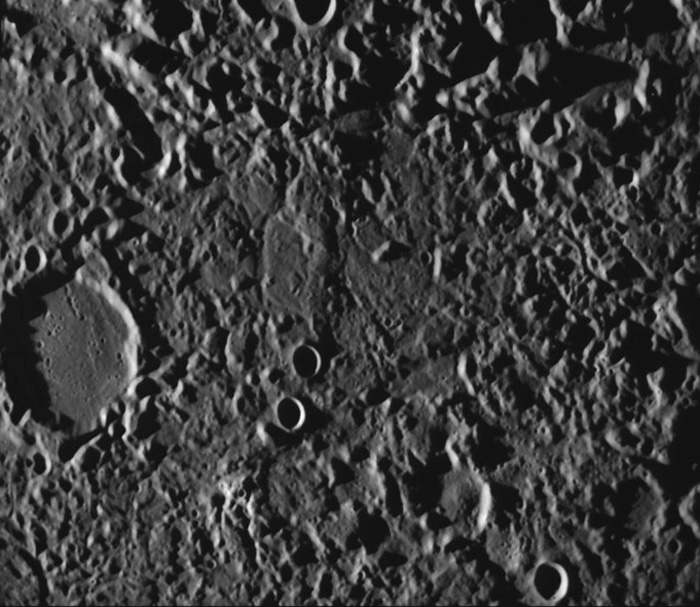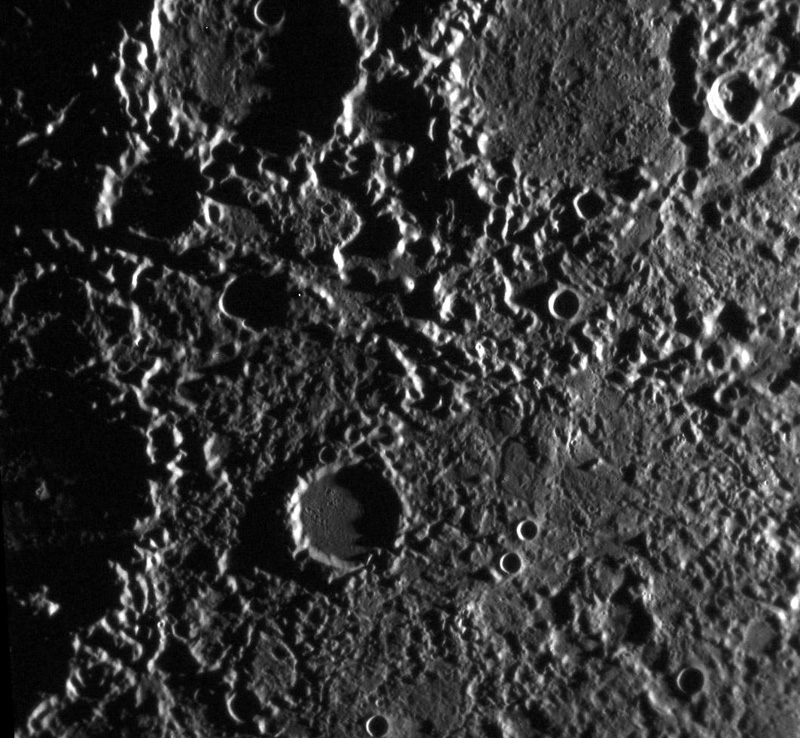A type of landscape on Mercury known as “chaotic terrain” might have released materials stored underground for eons.
Since the Mariner 10 probe approached Mercury in 1974, planetary scientists have been puzzled by a particular patch of land found on the opposite side of a large impact crater known as Caloris Basin. In the images Mariner 10 obtained, this land appeared like a jumbled area of hilly and uneven ground. Scientists dubbed it “chaotic terrain.”

NASA
For decades, the main idea for how this chaotic terrain formed had to do with the impact that made the large Caloris Basin. Massive seismic ripples caused by the impact could have resonated on the opposite side of the small world, causing massive quakes.
But a new study suggests a different origin. Alexis Rodriguez (Planetary Science Institute) and colleagues think that the terrain might have been made chaotic more gradually, as volatile elements susceptible to turn into gas that were stored underground evaporated over time. The team found that once enough of these volatiles escaped, the landscape deflated, creating irregular ground with drops of more than one kilometer. Their findings appear online March 16th in Scientific Reports.
“We found that chaotic terrain landscapes look like they had suffered significant relief losses, like you might have a mountain and suddenly half of it is missing,” Rodriguez explained. “But it isn’t like it has sunk into the terrain: it has just disappeared.”
Given that Mercury is a dry, airless world, Rodriguez says, there’s nowhere else for the materials to go — they must have turned to gas and gone away.
A Volatile World

NASA/Johns Hopkins University Applied Physics Laboratory/Carnegie Institution of Washington
The new work is based on observations made by NASA’s Messenger spacecraft, which orbited Mercury between 2011 and 2015 and mapped its terrain in unprecedented detail. The probe also determined the chemical makeup of the world’s surface, finding many volatile elements such as sulphur, chlorine, and potassium on its surface.
The presence of these elements surprised planetary scientists, who thought that the Sun’s proximity should long ago have stripped away any volatiles that Mercury formed with. Now, the new research suggests that volatile-rich layers could have existed for far longer than expected below the surface.
The researchers find evidence supporting their claim in crater counts and in ejecta rays. Counting the craters present in the chaotic terrain provides a proxy of its age, and the researchers obtain an age of 1.8 billion years — at least 2 billion years younger than the Caloris Basin.
Moreover, ejecta rays from recent craters disappear in some areas of the chaotic terrain, indicating that the ground has been degassing and changing until very recently, Rodriguez explained.
The team also found that chaotic terrain is not limited to the region opposite the Caloris Basin. Areas with similar texture don’t appear to be related to large impacts and are distributed from the poles to the equator. It’s possible that a volatile-rich crust might cover the whole planet.
“It's a fascinating work and I think it will spur quite a lot of research by other people,” said geochemist David Blewett, (Johns Hopkins University's Applied Physics Laboratory), who wasn’t involved in the new study.
Redefining Habitability
So what are in those volatile-rich layers? Rodriguez and his team consider several possibilities, one of which includes water in the mix.
“We aren’t talking about water ice — although it might have been at some point — but water that might be contained within phyllosilicates or maybe hydrated salts (brines),” Rodriguez said. “It doesn’t mean there could be lakes or caves filled with water, it means that water could have been trapped within mineral structures.”
If his team can prove the existence of water on Mercury, even in minerals, it could have implications for our definition of habitability. “Habitability and presence of life are two different things,” he adds. “I don’t think life has appeared in Mercury, but a prebiotic chemistry is much more likely.”
The same principle could apply to exoplanets, specifically small planets orbiting longer-lived stars such as red dwarfs. “Life might have a chance to appear, simply due to the amount of time that those systems could be stable,” Rodriguez says. “It makes it more likely, not definitive, but it surely increases the chances.”
“Yeah, I suppose,” Blewett counters, “but again, you know, Mercury doesn't have an atmosphere. It probably didn't have an atmosphere back at that time. And it seems unlikely that there would have been areas with the water and stability for the type of life as we know it.”
Confirmation of volatile-rich minerals, if there are any, could come from the BepiColombo spacecraft, due to arrive at the innermost planet in 2025 (after a flyby past Earth next week). BepiColombo will carry instruments that can survey Mercury as Messenger couldn’t, and will provide the ultimate test of the new idea.
 0
0









Comments
You must be logged in to post a comment.